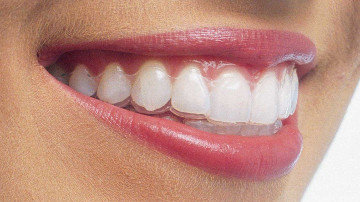Invisalign vs. Traditional Braces: Which Choice Is Right for You?
When taking into consideration orthodontic treatment, the selection in between Invisalign and standard dental braces provides numerous essential aspects that warrant careful evaluation. Invisalign uses a discreet choice with detachable aligners, while conventional braces provide an extra visible yet reliable solution for severe imbalance. Each option includes unique advantages and disadvantages associated with visual appeals, comfort, treatment duration, and price. Recognizing these subtleties is crucial for making an educated choice that lines up with your personal preferences and way of life. The concern remains: which option will best satisfy your orthodontic requirements and expectations?
Summary of Treatment Options

In contrast, conventional braces include steel braces and cords that are bonded to the teeth. This technique uses continuous stress over time to accomplish placement. While effective for complicated orthodontic problems, typical braces require routine visits for modifications and can present obstacles in keeping dental hygiene due to the difficulty of cleaning up around brackets and cables.
Both alternatives have their qualities, and the choice frequently depends upon certain oral problems, way of life choices, and person conformity. Inevitably, speaking with an orthodontic expert is important for establishing one of the most ideal therapy strategy tailored to private needs. Comprehending the nuances of each option can substantially influence the overall success of orthodontic therapy.
Aesthetic Considerations
A substantial element affecting the option in between Invisalign and standard braces is the visual charm each therapy uses. Invisalign aligners are crafted from clear plastic, making them practically invisible when used.
In contrast, typical braces include metal braces and wires, which can be a lot more noticeable. While improvements in orthodontic modern technology have brought about the development of smaller sized braces and colored elastics, standard dental braces still maintain a more obvious profile. For some people, the visibility of dental braces might discourage them from looking for needed therapy.
Ultimately, the selection between Invisalign and typical braces might rest on individual preferences regarding looks. Clients that prioritize discretion usually lean toward Invisalign, while those who are less worried about exposure might select typical braces. Recognizing the aesthetic effects of each choice is crucial for making an educated choice that aligns with one's way of life and choices.
Comfort and Convenience

In regards to ease, Invisalign aligners are removable, allowing people to appreciate their favored foods without restriction and preserve ideal dental health. about his Cleaning and flossing are streamlined, as the aligners can be taken out during these routines, whereas conventional dental braces call for careful maneuvering around brackets and cables.
Additionally, Invisalign's modern system enables less orthodontic brows through. Patients normally obtain multiple sets of aligners at the same time, which can simplify the treatment process and decrease time spent in the orthodontist's chair. On the other hand, conventional braces require routine modifications, making them less practical for those with busy schedules. Invisalign. In general, the comfort and convenience of Invisalign make it an appealing selection for several people seeking orthodontic therapy.
Treatment Period and Effectiveness
While both Invisalign and traditional braces work in fixing dental misalignments, the period of treatment can differ substantially in between both alternatives. Normally, Invisalign therapy can take anywhere from 12 to 18 months, depending upon the intricacy of the instance. The clear aligners work by slowly changing teeth into their wanted positions, and regular follow-ups with an orthodontist assistance make certain progress remains on the right track.
On the other hand, traditional braces commonly call for a longer commitment, typically ranging from 18 months to 3 years. This results from their set nature and using wires and brackets, which can be a lot more reliable for complicated situations and serious misalignments (Invisalign). The treatment efficiency of conventional dental braces is well-documented, as they enable exact changes and better control over tooth activity
Ultimately, the choice between Invisalign and traditional braces may hinge on both the expected therapy duration check it out and the certain oral problems available. Consulting with an orthodontist is critical, as they can provide customized referrals based on individual demands, guaranteeing the selected technique straightens with wanted outcomes and timeframes.
Cost Comparison and Insurance Coverage Choices
Expense plays a considerable duty in the decision-making procedure for individuals taking into consideration orthodontic treatment, whether choosing Invisalign or standard dental braces. Typically, the expense of Invisalign varieties from $3,000 to $8,000, while conventional braces usually cost between $2,000 and $6,000. Elements affecting these expenses include the intricacy of the case, the duration of therapy, and geographical location.
Numerous oral insurance strategies provide partial protection for orthodontic treatments, yet the specifics can vary widely. Generally, typical braces might be a lot more regularly covered by this post insurance coverage strategies compared to Invisalign, which some insurance firms classify as a cosmetic treatment.
Additionally, a number of orthodontic techniques offer versatile settlement plans, making both treatment choices extra easily accessible. Patients should ask about potential financing choices and price cuts for ahead of time settlements. Evaluating the total cost, including insurance benefits and repayment plans, is necessary for making an informed choice that straightens with both visual preferences and spending plan factors to consider.

Final Thought
In summary, the selection in between Invisalign and standard braces pivots on numerous aspects, including aesthetic choices, comfort, treatment duration, and price. Invisalign provides a discreet, removable choice that assists in oral health and dietary versatility, while traditional braces might be preferable for complex oral issues and commonly come at a lower rate point. Ultimately, appointment with an orthodontist is important to examine private conditions and identify the most ideal therapy option for accomplishing optimum oral alignment.
When thinking about orthodontic therapy, the selection in between Invisalign and traditional braces presents a number of crucial variables that warrant careful assessment.Comparing Invisalign and standard dental braces discloses distinctive treatment choices for orthodontic modification.While both Invisalign and traditional braces are effective in correcting dental misalignments, the period of therapy can differ considerably in between the 2 choices.Expense plays a substantial role in the decision-making procedure for individuals considering orthodontic therapy, whether choosing for Invisalign or typical braces.In recap, the selection in between Invisalign and traditional braces hinges on multiple aspects, consisting of visual preferences, comfort, therapy period, and cost.